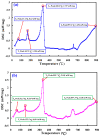Rotary Friction Welding of Dissimilar Polymer Rods Containing Metal Powder
- PMID: 38006079
- PMCID: PMC10675412
- DOI: 10.3390/polym15224354
Rotary Friction Welding of Dissimilar Polymer Rods Containing Metal Powder
Abstract
Three-dimensional printing is widely used for manufacturing a variety of functional components. However, the 3D printing machine substantially limits the size of the functional components. Rotary friction welding (RFW) is a possible solution to this problem. In addition, there is a notable scarcity of research directed toward the domain knowledge of RFW involving dissimilar polymer rods containing metal powder. In this study, two welding specimens fabricated by polylactic acid (PLA)-containing copper powder and PLA-containing aluminum powder were joined using a turning machine. After RFW, a bending test and a Shore A surface hardness test were performed to investigate the weld quality. It was found that the bending strength of the welded parts fabricated by RFW of PLA and PLA-containing Al powder rods can be enhanced by about 57.5% when the welded part is placed at 45 °C. Surface hardness test results showed that the surface hardness of the weld interface is better than that of the 3D printed parts, and the average surface hardness of the weld interface from RFW of PLA and PLA is the highest. The surface hardness of the weld joint is about 3% higher than that of the base material. The surface hardness of the heat-affected zone is about 3% lower than that of the base material. The average peak temperature of the welded joint is the highest in the RFW of PLA-containing Al powder and PLA-containing Al powder rods. The average peak temperature of the weld joint can be as high as 160 °C. The average peak temperature of the welded joint is the highest in the RFW of PLA-containing Cu powder and PLA-containing Cu powder rods. The average peak temperature of the welded joint can be as high as 144 °C. A technical database was built for the selection of ambient temperatures used for the RFW of dissimilar polymer rods containing metal powder and three base materials.
Keywords: aluminum powder; ambient temperature; copper powder; polylatic acid; rotary friction welding.
Conflict of interest statement
The authors declare no conflict of interest.
Figures
















Similar articles
-
Enhancing the Weld Quality of Polylactic Acid Biomedical Materials Using Rotary Friction Welding.Polymers (Basel). 2024 Apr 4;16(7):991. doi: 10.3390/polym16070991. Polymers (Basel). 2024. PMID: 38611249 Free PMC article.
-
Experimentation and Numerical Modeling of Peak Temperature in the Weld Joint during Rotary Friction Welding of Dissimilar Plastic Rods.Polymers (Basel). 2023 Apr 29;15(9):2124. doi: 10.3390/polym15092124. Polymers (Basel). 2023. PMID: 37177272 Free PMC article.
-
Mechanical Performance and Microstructural Evolution of Rotary Friction Welding of Acrylonitrile Butadiene Styrene and Polycarbonate Rods.Materials (Basel). 2023 Apr 22;16(9):3295. doi: 10.3390/ma16093295. Materials (Basel). 2023. PMID: 37176175 Free PMC article.
-
A Comprehensive Review on Optimal Welding Conditions for Friction Stir Welding of Thermoplastic Polymers and Their Composites.Polymers (Basel). 2021 Apr 8;13(8):1208. doi: 10.3390/polym13081208. Polymers (Basel). 2021. PMID: 33918015 Free PMC article. Review.
-
Friction Stir Spot Welding of Aluminum and Copper: A Review.Materials (Basel). 2019 Dec 31;13(1):156. doi: 10.3390/ma13010156. Materials (Basel). 2019. PMID: 31906198 Free PMC article. Review.
Cited by
-
Enhancing the Weld Quality of Polylactic Acid Biomedical Materials Using Rotary Friction Welding.Polymers (Basel). 2024 Apr 4;16(7):991. doi: 10.3390/polym16070991. Polymers (Basel). 2024. PMID: 38611249 Free PMC article.
References
-
- Lambiase F., Grossi V., Paoletti A. Effect of tilt angle in FSW of polycarbonate sheets in butt configuration. Int. J. Adv. Manuf. Technol. 2020;107:489–501. doi: 10.1007/s00170-020-05106-2. - DOI
-
- Delijaicov S., Rodrigues M., Farias A., Neves M.D., Bortolussi R., Miyazaki M., Brandão F. Microhardness and residual stress of dissimilar and thick aluminum plates AA7181-T7651 and AA7475-T7351 using bobbin, top, bottom, and double-sided FSW methods. Int. J. Adv. Manuf. Technol. 2020;108:277–287. doi: 10.1007/s00170-020-05370-2. - DOI
-
- Hassan A.J., Boukharouba T., Miroud D. Concept of forge application under effect of friction time for AISI 316 using friction welding process. Int. J. Adv. Manuf. Technol. 2021;112:2223–2231. doi: 10.1007/s00170-020-06421-4. - DOI
LinkOut - more resources
Full Text Sources

